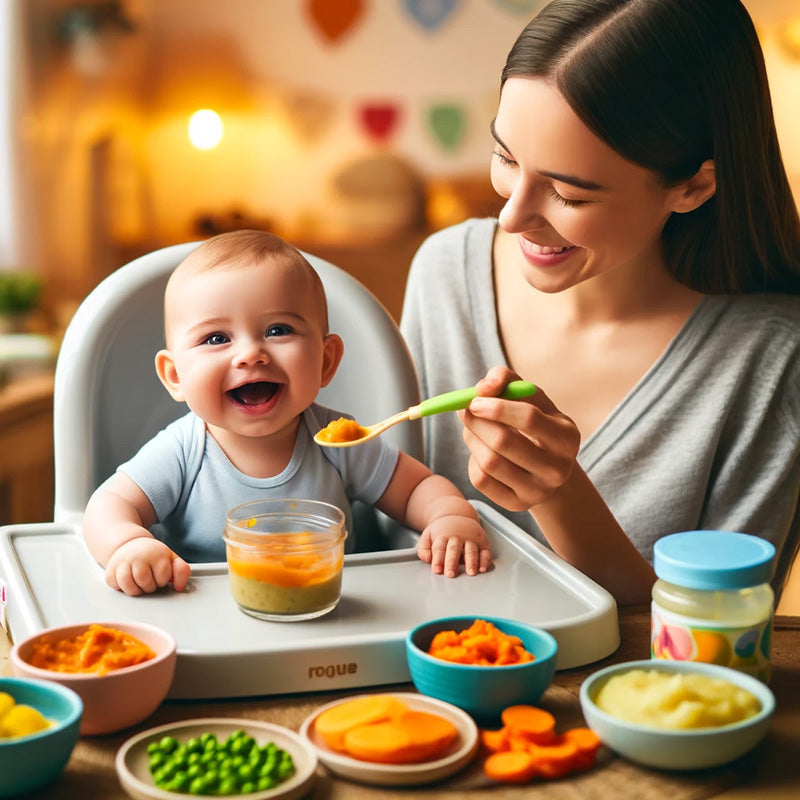FAST AND FREE SHIPPING ON MULTI-PACKS
FAST AND FREE SHIPPING ON MULTI-PACKS
Introducing Solids: A Joyful Journey for You and Your Baby

As your baby grows, you'll encounter many exciting milestones, one of which is introducing solid foods. This transition can feel daunting, but with the right guidance, you can make it smooth and enjoyable for both you and your baby. Here’s a comprehensive guide to help you navigate this important stage.
When to Start
The American Academy of Pediatrics (AAP) recommends introducing solids around six months of age. This is when most babies are developmentally ready and can benefit from the additional nutrients. However, some babies might show signs of readiness a bit earlier or later. Here are key indicators that your baby is ready for solids:
1. Sitting Up with Minimal Support: Your baby should be able to sit upright in a high chair or feeding seat.
2. Good Head Control: Your baby can hold their head up steadily.
3. Interest in Food: Your baby watches you eat, reaches for your food, or opens their mouth when food is offered.
4. Loss of Tongue-Thrust Reflex: Your baby no longer automatically pushes solids out of their mouth with their tongue.
5. Doubling of Birth Weight: Many babies are ready for solids when they have doubled their birth weight, typically around 13 pounds or more.
How to Start
Introducing solids doesn’t mean giving up on breast milk or your formula. These should still be your baby’s primary source of nutrition until at least one year old. Solids are initially just for practice and exploration.
1. Choose the First Foods
Single-ingredient, iron-fortified cereals like rice or oatmeal are popular first choices, such as our non-GMO, organic Holle porridges. Pureed vegetables, fruits, and meats are also great options. Here are some starter foods:
- Iron-fortified infant cereals (mixed with breast milk or formula)
- Pureed sweet potatoes, carrots, peas
- Mashed bananas, avocados, apples
2. One at a Time
Introduce new foods one at a time and wait 3-5 days before adding another. This helps you identify any food allergies or intolerances. Common allergens to introduce early (after consulting your pediatrician) include eggs, peanuts, and fish.
3. Small Portions
Start with 1-2 teaspoons of pureed food and gradually increase the amount. Remember, your baby is still getting used to the idea of eating solids, so it might take a few tries before they accept a new food.
4. Texture and Consistency
Begin with smooth purees and gradually move to thicker textures and small, soft lumps as your baby becomes more adept at eating. By 8-10 months, your baby can start enjoying finger foods like small pieces of soft fruits, well-cooked vegetables, and pasta.
5. Safe Feeding Practices
- Always supervise your baby while eating to prevent choking.
- Ensure the food is at a safe temperature.
- Avoid honey and cow’s milk until after the first year.
- Be cautious with foods that pose choking hazards like whole grapes, nuts, and popcorn.
6. Creating a Positive Mealtime Environment
- Consistency: Try to feed your baby solids around the same time each day, preferably when they are well-rested and not too hungry.
- Patience: Your baby might reject new foods initially. Keep offering them without forcing.
- Modeling: Eat together as a family to show your baby that mealtime is enjoyable and social.
7. Signs of Food Allergy
While food allergies are relatively uncommon, it’s important to watch for signs:
- Rash or hives
- Vomiting or diarrhea
- Swelling of the face or lips
- Difficulty breathing
If you notice any of these symptoms, stop feeding the new food and contact your pediatrician immediately.
8. Keeping Nutrition Balanced
Even though solids are being introduced, remember that breast milk or formula remains crucial for your baby’s growth. Continue to offer it regularly between solid meals.
Final Thoughts
Introducing solids is a significant step in your baby’s development. By paying attention to readiness cues and progressing slowly, you can ensure this transition is positive and enjoyable. Embrace the mess, enjoy the journey, and celebrate each new taste and texture your baby experiences.
For further guidance and tips on your baby’s nutrition, our experts at Bottles & Burps are here to help. We provide the cleanest, highest-quality European formulas designed to complement your baby’s diet and support their growth through every stage.
Subscribe
Sign up to get the latest on sales, new releases and more …
